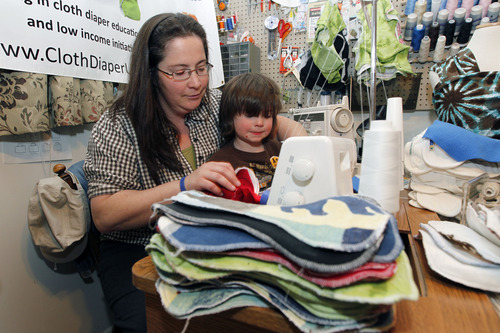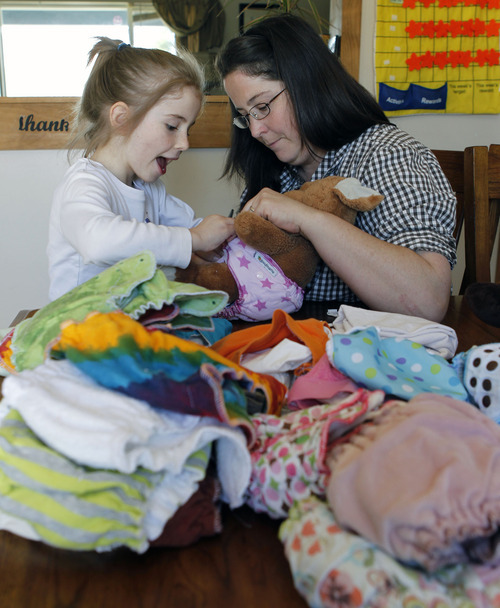This is an archived article that was published on sltrib.com in 2012, and information in the article may be outdated. It is provided only for personal research purposes and may not be reprinted.
Anita Palmer wants to put cloth on more babies' behinds and money in their parents' pockets.
Palmer has started a cloth-diaper bank to help low-income parents give cloth diapering a try. She believes it's better for babies, good for the environment and less costly in the long run than using disposable diapers.
"I am hoping to get people who normally wouldn't consider it," said Palmer, head of Cloth Diaper Utah and the driving force behind Utah's participation in the annual Great Cloth Diaper Change.
She is offering parents a one-hour class on how to use and care for cloth diapers, along with six handmade cloth diapers — enough for them to give cloth diapering a try for a few days to see if it's a viable option. Participants should meet income guidelines for the Women, Infants and Children program. Palmer is asking parents to pay $20 for use of the diapers and to cover expenses such as mailing out the diapers and sanitizing them when returned.
If parents decide cloth diapering works for them, Palmer will loan up to 18 additional reusable diapers. She said she is ready to help up to eight families make the switch from plastic to cloth; parents will have to buy their own pins or snaps, if needed, waterproof coverings and diaper pail.
Similar banks exist in California and in Dallas/Fort Worth.
Utah no longer has any cloth-diaper services. Harmons and several specialty shops, such as Honey Bump Maternity and Sandy-based clothdiaper.com, sell cloth diapers. Cost of a single diaper ranges from $6 to $30, Palmer said.
She estimates that a supply of cloth diapers sufficient to cover a baby's needs from birth to potty training would cost $300 to $500. "But you're done," she said.
Keeping baby in disposal diapers costs about $1,600, according to the Real Diaper Association.
True, cloth diapers require about two extra loads of wash a week, but Palmer believes disposable diapers are more likely to leak onto clothes, leading to more washing. Another selling point for her: Putting one child in cloth diapers until potty trained diverts almost a ton of garbage from going into a landfill, she said.
And there is this: "Children who are cloth diapered generally have less diaper rash and they potty train earlier," Palmer said.
According to the Real Diaper Association, diaper rash was almost unheard of before the 1940s, when use of rubber or plastic pants began.
Environmentally, the Natural Resources Defense Council considers the cloth-vs.-disposable debate a wash.
Sheila Walsh McDonald, low-income advocate for Salt Lake Community Action Program, said diapers are "one of the items in greatest demand."
Occasionally, the Utah Food Bank receives donated disposable diapers that it provides to its pantry partners, but such donations are hit and miss.
"I wouldn't say they are readily available," McDonald said. "It is probably one of the more consistent requests we get at the food pantry."
Palmer's cloth-diaper bank might work for some families who have a washer and dryer, but many of the program's clients are "highly mobile" and use laundromats.
"They would go through the same decision-making process as any other household would — what really meets their lifestyle needs at this stage of their lives," McDonald said.
Celeste Eggert, spokeswoman for The Road Home, said a few years ago someone else proposed starting a cloth-diaper program at the shelter but it "is not really feasible" given resources and living arrangements at the shelter.
But for people living in supported housing, "it is a great alternative," Eggert said. "We'd love to encourage our clients to be more environmentally friendly."
"If it comes between putting food in their babies' bellies, they are going to opt for food and rent rather than diapers," Eggert said. "But for those who are stable, it's a great idea."
A change is gonna come
Cloth-diaper advocates will again try to set a world record with the most diaper changes occurring at once.
The worldwide event will take place on April 21 at more than 260 locations in 15 countries. In Utah, parents and babies will gather at Calvary Chapel, 460 W. Century Drive, Murray, at 9 a.m. Last year, 64 Utah parents participated in the event. The world record is 5,026 participants.
For more information about Utah's cloth diaper community, see http://www.clothdiaperutah.org.
To learn more about the Cloth Diaper Utah bank, contact Palmer at clothdiaperutah@gmail.com





